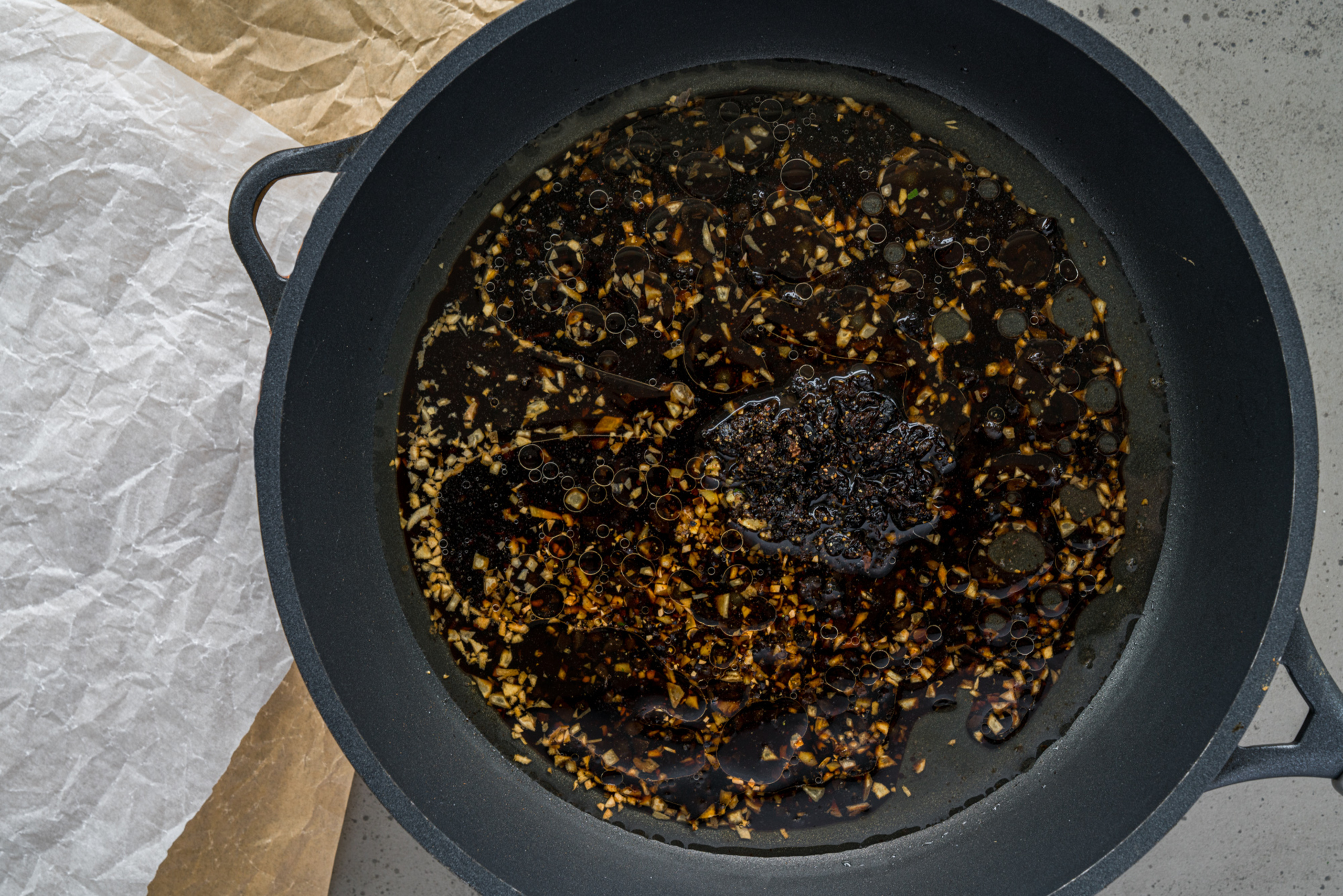Step 1: Making the Vinaigrette
- 1/4 cup light tasting oil (such as grape or canola)*
- 1 tbsp minced garlic
- 1 tsp minced ginger
- 2 tbsp fermented black beans, rinsed and minced
- 1/4 cup soy sauce
- 1/4 cup rice wine vinegar
- 1/4 cup mirin (sweet rice wine vinegar)
- 1 tbsp dark roasted sesame oil
- 2 tsp freshly ground black pepper
- 2 tbsp finely chopped chives or cilantro
- 1/2 minced jalapeño, optional
The first step is to fry the garlic. Before you start cooking the garlic, make sure you have all of your mise en place ready. The liquid will help to prevent the garlic from getting too dark and tasting bitter.
To start, place the oil and garlic into a fry pan and heat over medium-low heat. Let the garlic gently cook until it just starts to turn a light golden color. As soon as it’s ready, turn off the heat and add the ginger and fermented black beans. Stir to combine and then carefully add the soy sauce, rice vinegar, and mirin.
At this point, carefully add the vinaigrette to a jar or container and then add the sesame oil and black pepper. Once the vinaigrette has cooled, add the chives and/or cilantro and stir or shake to combine.
For a bit more heat, add either a bit of minced jalapeño or 1/4 teaspoon or so of chili flakes.
This vinaigrette can be used either warm or cold. It pairs well with salads, tofu, tempeh, and grilled or roasted vegetables—especially ones like Brussels sprouts, broccoli, cauliflower, gailan, and bok choy.
Note: This vinaigrette can be made using a bit less oil and/or it can be made a bit thicker. For either of these options, just start with about a tablespoon of oil and proceed with the recipe. In the end, you will want to thicken the vinaigrette with about a tablespoon of cornstarch (mixed with a tablespoon or so of water). In this case, bring the vinaigrette up to a gentle simmer and then add the cornstarch mixture—a bit at a time. Once you have reached the desired consistency, turn the heat to the lowest setting and let the vinaigrette cook for a minute or so, to cook out any cornstarch flavor.
Chef's Notes
Dried fermented black beans, which are actually dried soybeans, add an undeniable umami flavor to many Asian dishes. When thinking of Chinese fermented black beans, think of them how Italians would think of Parmesan cheese or how Indians would think of asafoetida — they add that “je ne sait quoi” and depth to dishes.
Fermented black beans, also know as douchi, are available in most Asian grocery stores, some regular grocers and can also be ordered online. They will keep for a very long time, up to a year, and you often only need a bit to add big flavor to a dish or sauce.
When thinking of these black beans don’t just think stir-fries and Asian foods, although they will still inherently add an Asian flair to whatever you add them too — they can also be added to a variety of other dishes — again, much like Parmesan cheese. With that being said, they are still really good friends with garlic and ginger — sort of like how carrots, celery, and onions are besties.
Besides ingredients like tempeh and tofu, common vegetables that fermented black beans pair well with are broccoli, cabbage (the whole family), onions, green beans.
Dried fermented black beans should be rinsed and rehydrated before cooking. To do so, either rehydrate in water or in whatever liquid you are using in your recipe — like soy sauce or vinegar for example.
For a more forward fermented black bean flavor, add the at the end of cooking and conversely, for a more subtle flavor, add them near the beginning with the other aromatics.



